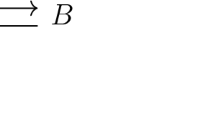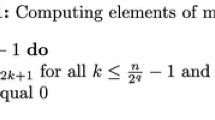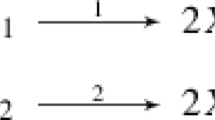Abstract
Reaction networks are mathematical models of interacting chemical species that are primarily used in biochemistry. There are two modeling regimes that are typically used, one of which is deterministic and one that is stochastic. In particular, the deterministic model consists of an autonomous system of differential equations, whereas the stochastic system is a continuous-time Markov chain. Connections between the two modeling regimes have been studied since the seminal paper by Kurtz (J Chem Phys 57(7):2976–2978, 1972), where the deterministic model is shown to be a limit of a properly rescaled stochastic model over compact time intervals. Further, more recent studies have connected the long-term behaviors of the two models when the reaction network satisfies certain graphical properties, such as weak reversibility and a deficiency of zero. These connections have led some to conjecture a link between the long-term behavior of the two models exists, in some sense. In particular, one is tempted to believe that positive recurrence of all states for the stochastic model implies the existence of positive equilibria in the deterministic setting, and that boundary equilibria of the deterministic model imply the occurrence of an extinction event in the stochastic setting. We prove in this paper that these implications do not hold in general, even if restricting the analysis to networks that are bimolecular and that conserve the total mass. In particular, we disprove the implications in the special case of models that have absolute concentration robustness, thus answering in the negative a conjecture stated in the literature in 2014.
Similar content being viewed by others
References
Anderson DF, Cotter SL (2016) Product-form stationary distributions for deficiency zero networks with non-mass action kinetics. Bull Math Biol 78(12):2390–2407
Anderson DF, Craciun G, Kurtz TG (2010) Product-form stationary distributions for deficiency zero chemical reaction networks. Bull Math Biol 72(8):1947–1970
Anderson DF, Enciso GA, Johnston MD (2014) Stochastic analysis of biochemical reaction networks with absolute concentration robustness. J R Soc Interface 11(93):20130943
Anderson DF, Craciun G, Gopalkrishnan M, Wiuf C (2015) Lyapunov functions, stationary distributions, and non-equilibrium potential for reaction networks. Bull Math Biol 77(9):1744–1767
Anderson DF, Robert B, Gheorghe C, Johnston MD (2018a) Conditions for extinction events in chemical reaction networks with discrete state spaces. J Math Biol 76(6):1535–1558
Anderson DF, Cappelletti D, Kim J, Nguyen TD (2018b) Tier structure of strongly endotactic reaction networks. Preprint arXiv:1808.05328
Anderson DF, Cappelletti D, Koyama M, Kurtz TG (2018c) Non-explosivity of stochastically modeled reaction networks that are complex balanced. Bull Math Biol 80(10):2561–2579
Ball K, Kurtz TG, Popovic L, Rempala G (2006) Asymptotic analysis of multiscale approximations to reaction networks. Ann Appl Probab 16(4):1925–1961
Brijder R (2015) Dominance and T-Invariants for Petri nets and chemical reaction networks. Lect Notes Comput Sci 9211:1–15
Cappelletti D, Joshi B (2018) Graphically balanced equilibria and stationary measures of reaction networks. SIAM J Appl Dyn Syst 17(3):2146–2175
Cappelletti D, Wiuf C (2016a) Elimination of intermediate species in multiscale stochastic reaction networks. Ann Appl Probab 26(5):2915–2958
Cappelletti D, Wiuf C (2016b) Product-form poisson-like distributions and complex balanced reaction systems. SIAM J Appl Math 76(1):411–432
Cappelletti D, Wiuf C (2017) Uniform approximation of solutions by elimination of intermediate species in deterministic reaction networks. SIAM J Appl Dyn Syst 16(4):2259–2286
Gopalkrishnan M, Miller E, Shiu A (2014) A geometric approach to the global attractor conjecture. SIAM J Appl Dyn Syst 13(2):758–797
Gunawardena J (2003) Chemical reaction network theory for in-silico biologists. http://vcp.med.harvard.edu/papers/crnt.pdf. Accessed Aug 2018
Johnston MD (2017) A computational approach to extinction events in chemical reaction networks with discrete state spaces. Math Biosci 294:130–142
Kang H-W, Kurtz TG (2013) Separation of time-scales and model reduction for stochastic reaction networks. Ann Appl Probab 23(2):529–583
Kang H-W, KhudaBukhsh WR, Koeppl H, Rempała GA (2019) Quasi-steady-state approximations derived from the stochastic model of enzyme kinetics. Bull Math Biol 81(5):1303–1336
Kurtz TG (1972) The relationship between stochastic and deterministic models for chemical reactions. J Chem Phys 57(7):2976–2978
Kurtz TG (1976) Limit theorems and diffusion approximations for density dependent Markov chains. In: Wets RJ-B (ed) Stochastic systems: modeling, identification and optimization I. Springer, Berlin, pp 67–78
Kurtz TG (1978) Strong approximation theorems for density dependent Markov chains. Stoch Process Appl 6(3):223–240
Norris JR (1998) Markov chains. Cambridge University Press, Cambridge
Pfaffelhuber P, Popovic L (2015) Scaling limits of spatial compartment models for chemical reaction networks. Ann Appl Probab 25(6):3162–3208
Shinar G, Feinberg M (2010) Structural sources of robustness in biochemical reaction networks. Science 327(5971):1389–1391
Author information
Authors and Affiliations
Corresponding author
Additional information
Publisher's Note
Springer Nature remains neutral with regard to jurisdictional claims in published maps and institutional affiliations.
D.F. Anderson is supported by Army Research Office Grant W911NF-18-1-0324.
Appendix
Appendix
1.1 Analysis of the mass action system (10)
Consider the bimolecular mass action system (10), which we repeat here for convenience.

The following holds.
-
The species A is ACR. Moreover, there exists at least one \(c>0\) with \(g(c)=0\). Indeed, we have that
$$\begin{aligned} g(c)=\begin{pmatrix} -\kappa _1c_1c_2+\kappa _7c_3\\ \kappa _2c_2c_3-\kappa _3c_2^2-\kappa _4c_2+\kappa _5c_5^2\\ \kappa _1c_1c_2-\kappa _2c_2c_3+\kappa _3c_2^2-\kappa _7c_3\\ 2\kappa _6c_5^2-\kappa _8c_4\\ {2\kappa _4c_2}-2(\kappa _5+\kappa _6)c_5^2+\kappa _8c_4 \end{pmatrix} \end{aligned}$$is zero if and only if \(c_2=c_3=c_4=c_5=0\) or
$$\begin{aligned} c=\left( \frac{\kappa _3\kappa _7}{\kappa _1\kappa _2}, s, \frac{\kappa _3}{\kappa _2}s, \frac{2\kappa _4\kappa _6}{\kappa _5\kappa _8}s, \sqrt{\frac{\kappa _4}{\kappa _5}s} \right) \quad \text {for some }s\in \mathbb {R}_{>0}. \end{aligned}$$ -
The reaction network has deficiency 2. Indeed,
$$\begin{aligned} S={{\,\mathrm{span}\,}}_\mathbb {R}\left\{ \begin{pmatrix} -1\\ 0\\ 1\\ 0 \\ 0 \end{pmatrix}, \begin{pmatrix} 0\\ 1\\ -1\\ 0 \\ 0 \end{pmatrix}, \begin{pmatrix} 0 \\ -1 \\ 0 \\ 0 \\ 2 \end{pmatrix}, \begin{pmatrix} 0\\ 0\\ 0\\ 1 \\ -1 \end{pmatrix} \right\} \end{aligned}$$and
$$\begin{aligned} \delta =|\mathcal {C}|-\ell -\dim S=10-4-4=2. \end{aligned}$$ -
There are two non-terminal complexes \(\overline{y}\ne \overline{y}'\) such that only the first entry of \(\overline{y}'-\overline{y}\) is different from 0. The two complexes \(A+B\) and B are non-terminal and their difference is A. Note that A is the only ACR species, and \(A+B\) and B are the only two non-terminal complexes whose difference has only one entry that is not zero.
-
The reaction network is conservative. Indeed, the vector (2, 2, 2, 1, 1) is a positive conservation law.
We will show that no extinction event can take place for the stochastically modeled mass action system, provided that
Assume that a state \(x'\) with \(\lambda _{A+B\rightarrow B+C}(x')=0\) is reachable from X(0). Then, there are two cases.
-
We have \(x'_2=0\). For any \(t\ge 0\), consider the quantity
$$\begin{aligned} h(t)=2X_2(t)+X_4(t)+X_5(t). \end{aligned}$$The only reaction capable of reducing h(t) is \(2B\rightarrow B+C\). This reaction decreases h(t) by 2, but it can only take place if at least 2 molecules of B are present, in which case \(h(t)\ge 4\). Hence, under the assumption that \(m(0)\ge 2\), for all \(t\ge 0\) we necessarily have \(h(t)\ge 2\). Since \(x'\) is reachable from X(0) and \(x'_2=0\), we have \(x'_4+x'_5\ge 2\). By potentially letting the reaction \(D\rightarrow E\) take place, we may assume that \(x'_4\ge 2\). Hence, the reaction \(2E\rightarrow B\) can occur and the number of molecules of B can become positive. At this point, either a state where \(A+B\rightarrow B+C\) is active is reached, or we consider the following case.
-
We have \(x'_2>0\) and \(x'_1=0\). We have three subcases:
-
If \(x'_3>0\), then a molecule of A can be created by the occurrence of \(C\rightarrow A\), which does not modify the number of molecules of B. Hence, a state can be reached where \(A+B\rightarrow B+C\) is active.
-
If \(x'_3=0\) and \(x'_2\ge 2\), then a molecule of B can be transformed into a molecule of C through \(2B\rightarrow B+C\), which only consumes one molecule of B. This subcase is therefore reduced to the previous one.
-
If \(x'_3=0\) and \(x'_2=1\), then
$$\begin{aligned} 4\le 2x'_1+2x'_2+2x'_3+x'_4+x'_5=0+2+0+x'_4+x'_5, \end{aligned}$$which implies that \(x'_4+x'_5\ge 2\). By potentially using the reaction \(D\rightarrow E\), we can assume that \(x'_4\ge 2\) and a molecule of B can be created by the reaction \(2E\rightarrow B\). This subcase is therefore reduced to the previous one.
-
It follows that no extinction set for \(A+B\rightarrow B+C\) is reachable from X(0). By consecutive applications of Proposition 4.1, it follows that the same occurs for all the other reactions as well, so no extinction event can occur.
1.2 Analysis of the mass action system (12)
Consider the bimolecular mass action system (10), which we repeat here for convenience.

We have the following.
-
The species A is ACR. Moreover, there exists at least one \(c>0\) with \(g(c)=0\). Indeed, it can be checked that
$$\begin{aligned} g(c)=\begin{pmatrix} -\kappa _1c_1c_2+\kappa _4c_3\\ -\kappa _1c_1c_2+\kappa _2c_3c_5-\kappa _3c_2c_4-\kappa _5c_2+\kappa _7c_5\\ \kappa _1c_1c_2-\kappa _2c_3c_5+\kappa _3c_2c_4-\kappa _4c_3\\ \kappa _2c_3c_5-\kappa _3c_2c_4+\kappa _5c_2-\kappa _6c_4\\ \kappa _1c_1c_2-\kappa _2c_3c_5+\kappa _3c_2c_4+\kappa _6c_4-\kappa _7c_5\\ \end{pmatrix} \end{aligned}$$is zero if and only if \(c_2=c_3=c_4=c_5=0\) or
$$\begin{aligned} c=\left( u,s, \frac{\kappa _1 u}{\kappa _4}s, \frac{\kappa _5}{\kappa _6}s, \frac{\kappa _5+\kappa _1u}{\kappa _7}s \right) \quad \text {for some }s\in \mathbb {R}_{>0}, \end{aligned}$$where u is the unique positive real number satisfying
$$\begin{aligned} \kappa _1^2\kappa _2\kappa _6 u^2+\kappa _1\kappa _2\kappa _5\kappa _6 u - \kappa _3\kappa _4\kappa _5\kappa _7=0, \end{aligned}$$namely
$$\begin{aligned} u=\frac{-\kappa _2\kappa _5\kappa _6+\sqrt{\kappa _2^2\kappa _5^2\kappa _6^2+4\kappa _2\kappa _3\kappa _4\kappa _5\kappa _6\kappa _7}}{2\kappa _1\kappa _2\kappa _6}. \end{aligned}$$ -
The reaction network has deficiency 1. Indeed,
$$\begin{aligned} S={{\,\mathrm{span}\,}}_\mathbb {R}\left\{ \begin{pmatrix} -1\\ -1\\ 1\\ 0\\ 1 \end{pmatrix}, \begin{pmatrix} 0\\ 1\\ -1\\ 1\\ -1 \end{pmatrix}, \begin{pmatrix} 1\\ 0\\ -1\\ 0\\ 0 \end{pmatrix}, \begin{pmatrix} 0\\ -1\\ 0\\ 1\\ 0 \end{pmatrix} \right\} \end{aligned}$$and
$$\begin{aligned} \delta =|\mathcal {C}|-\ell -\dim S=8-3-4=1. \end{aligned}$$ -
There are no non-terminal complexes \(\overline{y}\ne \overline{y}'\) such that \(\overline{y}'\ge \overline{y}\). This can be easily checked, since the only non-terminal complexes are \(A+B\) and C.
-
The reaction network is conservative. Indeed, the vector (1, 1, 1, 1, 1) is a positive conservation law.
We will show that under the assumption
no extinction event can occur for the stochastic model. To this aim, first note that the quantity
is always greater than or equal to 1. Indeed, the only reaction that can decrease this quantity is
However, under the action of this reaction h(t) decreases by 1, but the reaction is active only if at least one molecule of B and one molecule of D are present, implying \(h(t)=2\). Assume that a state \(x'\) is reachable from X(0), with \(\lambda _{A+B\rightarrow C+E}(x')=0\). This implies that one of the two following cases occurs.
-
We have \(x'_2=0\). Since \(h(t)\ge 1\) for all \(t\ge 0\), it follows that at least one molecule of D or one molecule of E is present. Hence, a molecule of B can be created by the reactions \(D\rightarrow E\) and \(E\rightarrow B\). Either a state where \(A+B\rightarrow C+E\) is active is reached, or we are in the following case.
-
We have \(x'_1=0\) and \(x'_2\ge 1\). One of the two following subcases holds.
-
We have \(x'_3\ge 1\). Then, a molecule of A can be created through \(C\rightarrow A\) and a state is reached where \(A+B\rightarrow C+E\) is active.
-
We have \(x'_3=0\). Hence,
$$\begin{aligned} 2\le m=x'_1+x'_2+x'_3+x'_4+x'_5=x'_2+x'_4+x'_5. \end{aligned}$$Thanks to the reactions \(B\rightarrow D\), \(D\rightarrow E\), and \(E\rightarrow B\), we can transform all the molecules of B, D, and E into at least one molecule of B and one molecule of D, so that a state where \(B+D\rightarrow C+E\) is active is reached. Upon the action of \(B+D\rightarrow C+E\), a molecule of C is then produced, and this subcase reduces to the previous one.
-
In conclusion, no extinction set for \(A+B\rightarrow C+E\) is reachable from X(0). By applying Proposition 4.1, it follows that the same holds for the other reactions. Hence, no extinction event can occur.
Rights and permissions
About this article
Cite this article
Anderson, D.F., Cappelletti, D. Discrepancies between extinction events and boundary equilibria in reaction networks. J. Math. Biol. 79, 1253–1277 (2019). https://doi.org/10.1007/s00285-019-01394-9
Received:
Revised:
Published:
Issue Date:
DOI: https://doi.org/10.1007/s00285-019-01394-9
Keywords
- Reaction networks
- Continuous time Markov chains
- Ordinary differential equations
- Limit behaviour
- Absorbing states
- Absolute concentration robustness




